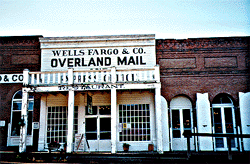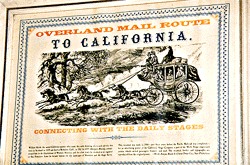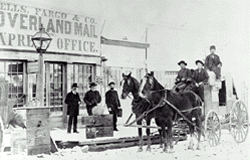Wells Fargo
Updated: August 24, 2020

Ben Holladay's Overland Stage Line reached Virginia City in August, 1864. From that time until 1889, their express office occupied the old frame building which stood on this site. From this office, taken over by Wells, Fargo & Company when they bought out Ben Holladay in 1866, stages made connections with the entire West and "The States." Those arriving in Virginia City came first to the building, and those departing said good-bye from here. Fortunes in gold crossed its desk, and the telegraph office was here as well.

In 1899 the Wells Fargo office evidently moved into the building where it is located as a display today. S. R. Buford purchased the lot where the original building stood. He had the Old Wells Fargo office torn down and roofed between his 1875 and 1866 brick stores to produce a grocery department. The new structure, called the Buford Block was the center of merchandising in this part of Montana for the next quarter century. S. R. Buford died in 1905, but his business was carried on by his sons Charles, Walter, and Luther until 1926.

In 1932 Kenneth Baker opened a mortuary in the center part of the Buford Block. The shelving, counters and even a hand-operated elevator were removed and stored in the large, tin shed across the alley where Buford had kept agricultural implements. They were still there when the Boveys found them. Charles Raper bought the mortuary in 1935 and moved it up the street to Creighton's Stone Block in 1940. The Buford Block then stood empty until Charles Bovey purchased it from the Elling estates in 1947. They opened the Wells Fargo Coffee House the same year. The name, of course, is derived from the Old Wells Fargo building, which previously occupied this site.
In changing the Buford Block into the Coffee House, the side buildings remained nearly unaltered. The center, however, was somewhat remodeled. The middle part, when completed in 1900, had big plate-glass windows and a reverse bay-door entry, while the brick above was capped with a metal cornice. The plate-glass windows were replaced with small-paned windows patterned after the original Wells Fargo building. A porch was added, and the old Wells Fargo sign was duplicated on wood siding over the brick façade.
Inside, the balcony, at the rear, is still there, now serving as an apartment for the cook. A partition was added and modern kitchen equipment was installed; otherwise, the building remains unchanged. The original tin ceiling, a true example of art, is intact.
Special acknowledgements to: John D. Ellingsen, John N. DeHaas, Tony Dalich, and Ken Sievert Tom Cook and Ellen Baumler of the Montana Historical Society.
Updated: August 24, 2020

